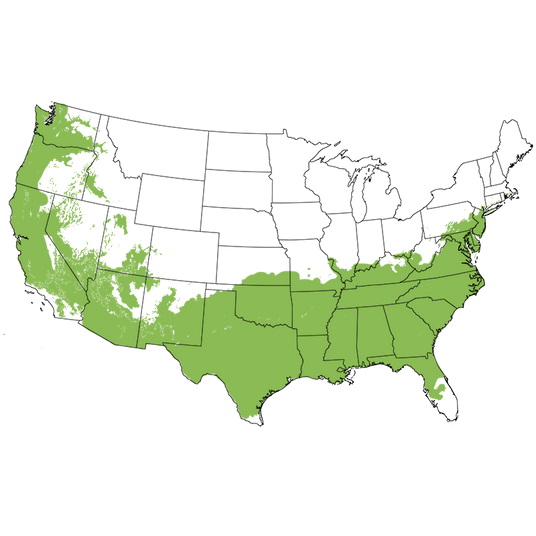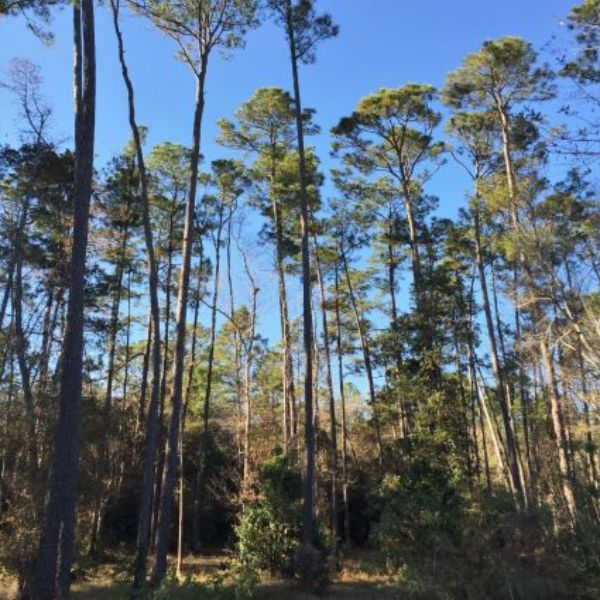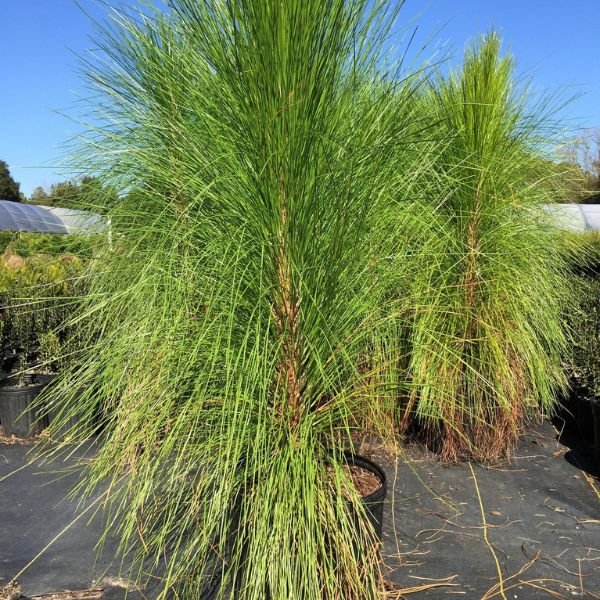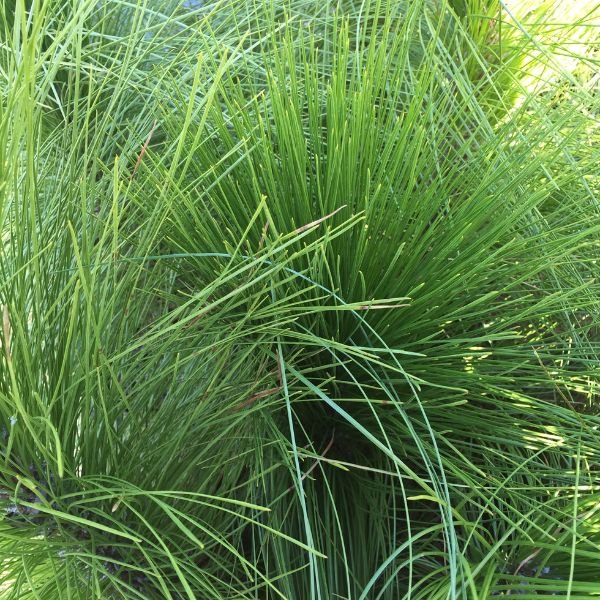Longleaf Pine
Pinus palustris
Plant Sentry™
Plant Sentry™

Plant Sentry™ Protected
Your order is protected by our compliance system that:
- Prevents restricted plants from shipping to your state
- Ensures plants meet your state's agricultural requirements
- Protects gardens from invasive pests and diseases
Delivery and Shipping
Delivery and Shipping
Delivery and Shipping
Fast, Safe Plant Delivery
Ships in 3-4 business days • Tracking provided • Weather protected
| Under $50 | $9.99 |
| $50 - $99.99 | $14.99 |
| $100 - $149.99 | $16.99 |
| $150 - $198.99 | $24.99 |
| $199+ | FREE |
✓ Zone-specific timing • ✓ Professional packaging • ✓ Health guarantee
Understanding Plant Options
Nature Hills offers plants in two main formats:
- Container Plants: Grown in pots with soil, sized by container volume and plant age
- Bare Root Plants: Dormant plants without soil, sized by height measurements
Container Plant Sizes
Container sizes indicate plant age and growing capacity rather than liquid volume equivalents. Our containers follow industry-standard nursery "trade gallon" specifications, which differ from standard liquid gallon measurements.
Young Plants (6 months to 18 months old)
| Container Size | Actual Volume | Metric Equivalent |
|---|---|---|
| 2" x 2" x 3" | 0.18 - 0.21 dry quarts | 0.20 - 0.23 dry liters |
| 4" Container | 0.31 - 0.87 dry quarts | 0.35 - 0.96 dry liters |
| 4.5" Container | 0.65 dry quarts | 0.72 dry liters |
| 6" Container | 1.4 dry quarts | 1.59 dry liters |
| 1 Quart | 1 dry quart | 1.1 dry liters |
| 5.5" Container | 1.89 dry quarts | 2.08 dry liters |
Established Plants (18 months to 2.5 years old)
| Container Size | Actual Volume | Metric Equivalent |
|---|---|---|
| 2 Quart | 2 dry quarts | 2.2 dry liters |
| #1 Container | 2.26 - 3.73 dry quarts | 2.49 - 4.11 dry liters |
| 5" x 5" x 12" | 3.5 - 4.3 dry quarts | 3.85 - 4.74 dry liters |
Mature Plants (2-4 years old)
| Container Size | Actual Volume | Metric Equivalent |
|---|---|---|
| #2 Container | 1.19 - 1.76 dry gallons | 5.24 - 7.75 dry liters |
| #3 Container | 2.15 - 2.76 dry gallons | 8.14 - 12.16 dry liters |
Large Plants (3-5 years old)
| Container Size | Actual Volume | Metric Equivalent |
|---|---|---|
| #5 Container | 2.92 - 4.62 dry gallons | 12.86 - 20.35 dry liters |
| #6 Container | 5.25 - 6.01 dry gallons | 23.12 - 26.42 dry liters |
| #7 Container | 5.98 - 6.53 dry gallons | 26.34 - 28.76 dry liters |
Bare Root Plants
Bare root plants are sold by height from the root system to the top of the plant. Plants may exceed minimum height requirements.
Common Sizes:
- Trees: 1 foot, 2 feet, 3 feet, 4 feet, 5 feet, 6 feet
- Shrubs & Perennials: 1 foot, 18 inches, 2 feet
Important Notes
Container Volume Specifications
- Trade Gallon Standard: Our containers follow industry-standard "trade gallon" specifications established by the American National Standards Institute (ANSI Z60.1) for nursery stock
- Volume Variations: Actual soil volume may vary due to plant root systems and growing medium settlement
- Age Indicators: Container size primarily indicates plant age and maturity rather than liquid volume equivalents
Growing Conditions
- Plant size can vary based on variety and growing conditions
- Container size helps indicate plant maturity and establishment level
- Larger containers generally mean more established root systems and faster landscape establishment
Seasonal Availability
- Bare root plants are available seasonally when dormant
- Container plants are available throughout the growing season
- Specific varieties may have limited availability in certain sizes
Questions?
For questions about specific plant sizes or availability, please contact our plant experts who can help you choose the right size for your landscape needs.

Plant Sentry™ Protected
Your order is protected by our compliance system that:
- Prevents restricted plants from shipping to your state
- Ensures plants meet your state's agricultural requirements
- Protects gardens from invasive pests and diseases
Plant Profile & Growing Essentials
Cold hardy, Evergreen, Low Maintenance, Hedge/Screen, Heat Tolerant, and Drought resistant
Specifications
Specifications
-
Botanical Name
-
Height
-
Width
-
Growing Zones
-
Sunlight
-
Growth RateSlow
-
Leaf Color
-
Fall Color
-
NativeYes
-
Pollinator Required
-
Bloom PeriodLate Spring
Planting & Care Instructions
Planting & Care Instructions

Growing Zones 7-9
The magnificent native Longleaf Pine Tree (Pinus palustris) remains a vitally important resource for family forest owners throughout the Southeast US. They provide saw timber and pine straw mulch that brings enormous value! After all, a well-managed stand of Longleaf Pines can supply family income for your grandchildren and great-grandchildren.
An interesting Pine that is almost grassy-looking when very young, these are slower-growing trees while they get established. Longleaf Pines need to form a long tap root that is essential to their longevity, but once it gets established it can easily add about 2 feet of new growth each year! Under optimal conditions, Longleaf Pine can grow to be very tall and live for hundreds of years.
An excellent evergreen conifer, mature trees have an incredibly straight trunk with limbs that start about 50 feet high off the ground. They are heavy, resist rot and termite damage, and were used to make power lines and telephone poles. The straight trunk is covered in a blocky, textured bark that is brown with warm, orange overtones. It brings a big visual presence to the landscape!
Stick-straight Longleaf Pine trunks have also been known to tempt agile young human "climbers", who shimmy up the long length and then blissfully ride the branches as the soft-textured canopy sways back and forth in the slightest breeze. (But you never did anything like that, did you?)
New growth buds appear silvery white and are particularly attractive in the winter landscape! Aging into incredibly long, dark green needles that hold on the tree over 2 growing seasons, then fall to the ground as pine straw mulch. Gardeners throughout the South love using pine straw to mulch their flower beds. This valuable wood product can be baled, processed, and sold with proper state certification.
The Importance of Longleaf Pine Trees
Native Longleaf Pine forests once covered 92 million acres of coastal plain in the Southeastern United States. Overharvesting the old growth and recent short-sighted clear-cutting practices have caused a devastating loss of habitat in excess of 97% of the presettlement range.
But today, this beautiful tall tree is making a comeback. This is thanks to the hard work of restoration groups who are replanting ancient Longleaf Pine regions throughout USDA growing zones 7 to 9.
There is nothing so restful and soothing to the soul as a properly managed Pine Savannah. Filtered sunlight breaks through the tree's canopy allowing for the cultivation of grasses, Sedges, and other perennial plants to grow under their canopies. Native wildflowers thrive underneath their filtered shade, as do architectural sweeps of native Wiregrass.
The pine cones are 10 inches long and the seeds feed Pheasant, Turkey, Quail, and Squirrel. Of course, Longleaf Pine is also a friend to a wide web of native animals, including the Red-Cockaded Woodpecker, Brown-Headed Nuthatch, harmless Indigo Snake, and Gopher Tortoise.
- Attractive, Extremely Long, Soft, Weeping Needles
- Grow Fluffy Young "Grass Stage" Trees in Large Containers for Years
- Highly Textured, Colorful Bark
- Wildlife Tree Brings Turkey, Pheasant & Bobwhite Quail
- Valuable for Timber & Pine Straw Mulch
- Incredible Visual Screen as Border Along Your Property Line
- Historical Native Tree - Install a Legacy For Your Great-Grandchildren
How to Use Longleaf Pine in the Landscape
Understand the goals for your property to maximize earning potential from logging. Forestry experts are now recommending an uneven-aged management approach to forests, with a mix of young and old trees to allow a continuous stream of income from timber every 7 to 12 years and a higher net income.
Restoring previously cleared land is a worthwhile effort. Add Longleaf Pine as a long-term species in a diversified reforestation effort. Faster-growing trees can be strategically added, then removed for cut timber first as they reach the goal. Allow the more valuable Longleaf Pine trees to mature and provide a seed source.
There are other ways to use this valuable tree, as well. A beautiful shelterbelt, windbreak, or border of Longleaf Pines marching along the length of a property line makes a wonderful visual screen. You'll love the way these highly textured trees look when planted in a very formal way.
Plant them 6 feet apart on center, measuring from the center of one to the center of the next. This spacing gives you and your family a welcome sense of separation from neighboring properties.
Young Longleaf Pines are so cute. They might remind you of that old cartoon, "Captain Caveman" as they go through a fluffy "grass phase" before the trunk expands to push the canopy high up in the air.
These shaggy baby trees have so much character, with long, weeping needles growing in soft-bristled tufts at the tips of the branches. Why not try a few as a focal point in a series of large containers for several years?
They would be a fun, short-term accent with a wonderfully casual look. Use them as an effective, memorable privacy screen for a few years, then sell them, transplant them or donate to a local restoration project.
Recommended for larger landscapes, parks, and woodland restoration, Longleaf Pine trees are also known as Southern Yellow Pine and "Pitch Pine". They produce pitch, which has been used as tar, resin, and turpentine.
Because of this pitch, they should be planted at least 100 yards away from structures as a precaution to prevent fire damage in your defensible space.
Periodic, smoldering slow fires have been part and parcel of the Southern Piney Woods for eons. Controlled burns are now recommended as a part of proper stand management. Work with your state forestry commission office for help finding professionals who are versed in prescribed burning using proper scientific methods. Controlled burns rejuvenate your soil and clear competing brush out of the woods.
#ProPlantTips for Care:
Growing a Longleaf Pine is easy! Give your trees a planting site in well-drained soil in full sun for best results. Provide regular moisture while young trees are establishing with a 3-4 inch thick layer of mulch over the soil surface to hold in moisture and keep the roots cool as they develop.
In their grass phase, Pines work to establish their root systems in your native soil before much upward growth is noticed. As it matures, it becomes a stately, low-maintenance tree. It's even self-pruning, so there really isn’t any work for you, with the trunk eventually soaring upward straight and true.
- Full Sun
- Moderate to Low Moisture Needs Once Established
- Any Well-Drained Soil
- Shows Resistance to Pine Tip Moth & Southern Pine Beetle
- Easy Care, Drought & Salt Resistant
Our top-rated, field-grown plants are securely packaged and shipped directly to your door. Nature Hills growers take special pride in producing top-quality plants for your property. Order Longleaf Pine from Nature Hills today.












